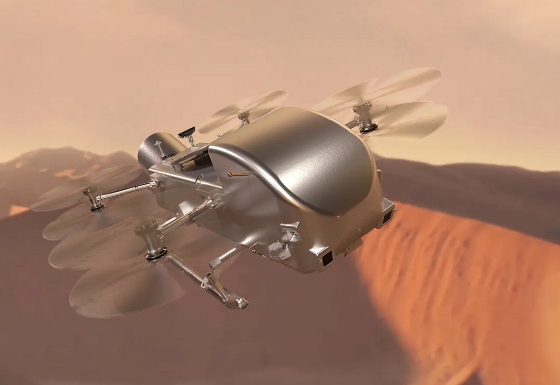 |
| April 23, 2024 | Volume 20 Issue 16 |
Designfax weekly eMagazine
Archives
Partners
Manufacturing Center
Product Spotlight
Modern Applications News
Metalworking Ideas For
Today's Job Shops
Tooling and Production
Strategies for large
metalworking plants
NASA confirms it will send car-sized Dragonfly rotorcraft to Saturn moon Titan

Artist's concept of Dragonfly soaring over the dunes of Saturn's moon Titan. [Credit: NASA/Johns Hopkins APL/Steve Gribben]
NASA has confirmed its Dragonfly rotorcraft mission to Saturn's organic-rich moon Titan is a go. The decision allows the mission to progress to completion of final design, followed by the construction and testing of the entire spacecraft and science instruments.
"Dragonfly is a spectacular science mission with broad community interest, and we are excited to take the next steps on this mission," said Nicky Fox, associate administrator, Science Mission Directorate at NASA Headquarters in Washington. "Exploring Titan will push the boundaries of what we can do with rotorcraft outside of Earth."
In early 2023, the mission successfully passed all the success criteria of its Preliminary Design Review. At that time, however, the mission was asked to develop an updated budget and schedule to fit into the current funding environment. This updated plan was presented and conditionally approved in November 2023, pending the outcome of the fiscal year 2025 budget process. In the meantime, the mission was authorized to proceed with work on final mission design and fabrication to ensure that the mission stayed on schedule.
Titan's atmosphere is four times denser than Earth's, and a rotorcraft would need 38 times less power to hover above the surface.
Dragonfly is a quadcopter drone with a nominal mass of 400 to 450 kg and will be roughly the size of the largest Mars rover (Curiosity is about the size of a MINI Cooper). It flies using 8 rotors (each has a diameter of around 1 m), attached as four pairs to outriggers mounted on the side of the body. The craft can fly at about 10 m/s, and reach altitudes of 4,000 m. Two landing skids protrude from the bottom of the craft. Power (nominally 70 W) is supplied by a radioisotope thermoelectric generator (RTG) mounted in a cylinder on the back of the drone, stored in rechargeable batteries. There is very little wind on Titan, but there is methane rain.
Dragonfly will have the ability to fly for approximately half an hour and cover distances up to roughly 10 km on a single (8-day) battery charge. Each skid is equipped with a sampling drill, part of the DrACO sampling system. Science instruments include a mass spectrometer (DraMS), a gamma-ray spectrometer (DraGNS), a geophysical and meteorology package (DraGMet), as well as a suite of cameras (DragonCam).
With the release of the president's fiscal year 2025 budget request, Dragonfly is confirmed with a total lifecycle cost of $3.35 billion and a launch date of July 2028. This reflects a cost increase of about two times the proposed cost and a delay of more than two years from when the mission was originally selected in 2019. To compensate for the delayed arrival at Titan, NASA also provided additional funding for a heavy-lift launch vehicle to shorten the mission's cruise phase.
The rotorcraft, targeted to arrive at Titan in 2034, will fly to dozens of promising locations on the moon, looking for prebiotic chemical processes common on both Titan and the early Earth before life developed.
It is expected to cover roughly 180 km over the course of the 2.7 Earth-year nominal mission, ending up in 80-km diameter Selk Crater, north of the initial landing site.

Dragonfly team members pause during the mission preliminary design review, held at the Johns Hopkins Applied Physics Laboratory in Laurel, MD, on Feb. 25, 2023. A prototype of the Dragonfly vehicle is also shown in the photo. [Credit: NASA/Johns Hopkins APL]
Dragonfly is being designed and built under the direction of the Johns Hopkins Applied Physics Laboratory (APL) in Laurel, Maryland, which manages the mission for NASA. Elizabeth Turtle of APL is the principal investigator. The team includes key partners at NASA's Goddard Space Flight Center in Greenbelt, Maryland; Lockheed Martin Space in Littleton, Colorado; NASA's Ames Research Center in Silicon Valley, California; NASA's Langley Research Center in Hampton, Virginia; Penn State University in State College, Pennsylvania; Malin Space Science Systems in San Diego, California; Honeybee Robotics in Pasadena, California; NASA's Jet Propulsion Laboratory in Southern California; CNES (Centre National d'Etudes Spatiales) in Paris; the German Aerospace Center (DLR) in Cologne, Germany; and JAXA (Japan Aerospace Exploration Agency) in Tokyo.
Dragonfly is the fourth mission in NASA's New Frontiers Program, managed by NASA's Marshall Space Flight Center in Huntsville, Alabama, for the agency's Science Mission Directorate in Washington.
Sources: NASA, Johns Hopkins APL
Published April 2024
Rate this article
View our terms of use and privacy policy
